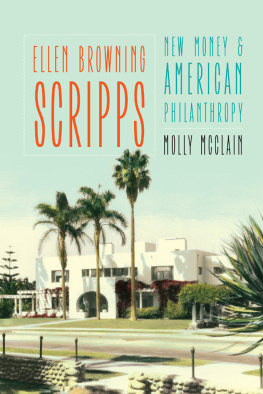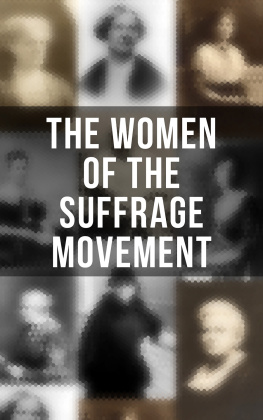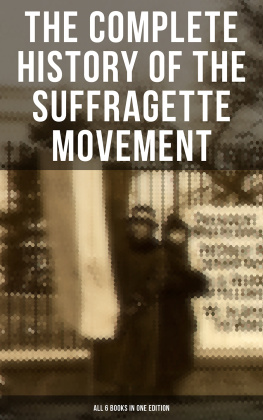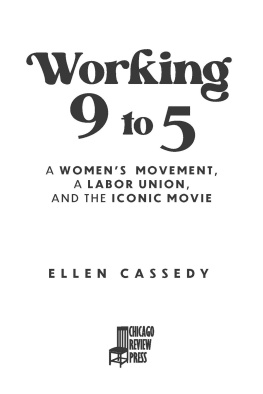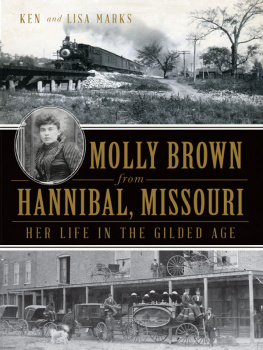Contents

McClains biography of Ellen Browning Scripps isnt just about a beloved San Diego philanthropist. [It] is also a history of womens fight for equality, the rise of mass-market media, Detroit as a booming industrial center, and San Diego as an upstart West Coast center of innovation. Scripps appeared on the cover of Time magazine in the 1920s, and she still warrants attention nearly a century later.Roger Showley, staff writer for the San Diego Union-Tribune
[Ellen Browning Scrippss] progressive legacy undergirds the best of San Diego. This compelling book breaks the glass ceiling in the genre of Southern California biographies.Mike Davis, author of City of Quartz: Excavating the Future in Los Angeles
McClain has shed light on the lesser-known landscape of West Coast philanthropy in which Miss Scripps played such a significant role. McClains proficiency and passion for her topic are sans pareil .Eric T. Haskell, professor of French studies and humanities and director of the Clark Humanities Museum at Scripps College
Few philanthropists in San Diegos history have had the impact of Ellen Browning Scripps. San Diego Union-Tribune
What a life! Ellen Browning Scripps made an astonishing amount of money, lived a very long time, and gave millions away. In doing so she changed the landscape of the far West and earned for herself a pivotal place in American philanthropy. This fine book gives Scripps her due. William Deverell, director of the Huntington- USC Institute on California and the West
A skillful and loving tribute to Ellen Browning Scripps, one of Americas least-known yet influential philanthropists. This is the inspiring true story of how one person has made a difference in the world.William Lawrence, executive director of the San Diego History Center
McClains biography of this remarkable philanthropist and journalist is a gift to all readers.Hannah S. Cohen, coauthor of Women Trailblazers of California: Pioneers to the Present
McClain offers a riveting portrait of how one womans pragmatic yet free-spirited generosity greatly enhanced the region by privileging social justice over personal gain.Seth Mallios, coauthor of Cemeteries of San Diego
McClain brilliantly captures the uniquely American story of the remarkable Ellen Browning Scripps.Heath Fox, executive director of the La Jolla Historical Society
This definitive and comprehensive examination of Ellen Browning Scripps and her wide-ranging contributions to women and the larger community is greatly welcomed by those of us who value the power of the written word, especially at this time in our history when the stories of womens accomplishments can serve as a beacon to girls and young women everywhere.Ashley Gardner, executive director of the Womens Museum of California
Compelling. Molly McClain has an extraordinary ability to bring this amazing lady alive as a role model for women of all ages and backgrounds.Doug Dawson, executive director of the Ellen Browning Scripps Foundation
This book is well written, extraordinarily thorough and informative, and is a strong contribution to California, media, and womens history. This is a terrific story.Kathleen A. Cairns, author of The Case of Rose Bird: Gender, Politics, and the California Courts


2017 by the Board of Regents of the University of Nebraska
All rights reserved
Publication of this volume was assisted by a grant from the Friends of the University of Nebraska Press.
Library of Congress Control Number: 2017936202
Set in Janson by Rachel Gould.
Designed by N. Putens.
The publisher does not have any control over and does not assume any responsibility for author or third-party websites or their content.
To my beloved sister, Cady
Illustrations
Following page 76
Following page 102
PREFACE
California, 1903.
She was a plain woman. Soft-spoken, with only a trace of an English accent. Just over sixty-six years old, she attracted little interest among the travelers on the train that wound its way along the Pacific Coast from the seaside colony of La Jolla to its terminus in San Diego, California. Her clothes, though expensive, were several years out of date.
Then she smiled. Her face softened, and the lines around her eyes creased with pleasure at the sight of three small children seated on a horse-drawn wagon. When the train stopped at the station, she rose quickly, went to the door, and waved.
Startled, a fellow passenger nearly said aloud, Oh, how beautiful she is!
The woman was Ellen Browning Scripps. In her youth, she had been an editor, a writer, and an active supporter of womens suffrage. She worked alongside hard-drinking journalists in Detroit newsrooms and campaigned for Susan B. Anthony. A shrewd businesswoman, she invested her money in the rapidly expanding Scripps chain of newspapers until she became a millionaire several times over. Like other nineteenth-century women, she endured the kind of discrimination one can only imagine today. She had earned her wrinkles and the right to wear an old-fashioned hat.
Life experiences, however, had not hardened Scripps but made her more compassionate. Recognizing that many people struggled to compete in an increasingly capitalist society, she worked to improve educational opportunities for ordinary men and women. In the faces of children she saw the potential for a new world governed by hope and guided by a sense of community. She trustedand investedin that.
ACKNOWLEDGMENTS
I am very grateful to Scripps College for permitting me to use the extensive Ellen Browning Scripps Collection. Judy Harvey Sahak, former director of the Ella Strong Denison Library, offered invaluable guidance and insight, while Dorran Boyle kindly assisted with various requests. Research materials and photographs also were made available at the following institutions: Altadena Historical Society; Beverly Hills Public Library; The Bishops School; University of California, San Diego; The Huntington Library; La Jolla Historical Society; La Jolla Womans Club; the Fogler Library at the University of Maine; the Bentley Historical Library at the University of Michigan; San Diego History Center; San Diego Public Library; Scripps Institution of Oceanography; and the Beinecke Library, Yale University. Special thanks to the staff of the Mahn Center for Archives & Special Collections at Ohio University Libraries for their assistance during my visit and for making much of the E. W. Scripps Collection available online.
This book could not have been written without the encouragement and support of many colleagues and friends. I am very grateful to Iris H. W. Engstrand for her encyclopedic knowledge of San Diego history and her steadfast friendship. John Trifiletti encouraged me to start what we both thought would be a short project. Several friends read drafts of the text and offered criticisms and corrections. My most sincere thanks to Cynthia L. Caywood, Colin Fisher, Mark A. Kishlansky, and Jerry Stratton for finding errors that escaped my eye. James B. Guthrie both read the manuscript and provided valuable insights into the life and career of architect Irving J. Gill. Derrick R. Cartwright, meanwhile, shared his research on artist Robert Henri. I also appreciate the helpful information provided by Mary Katherine Allman, Mary Boehm, Diane Kane, Carol Olten, Sandra Spalding, and Suzanne Weiner. My beloved dog, Twister, meanwhile, helped me to sit and stay long enough to complete this book.

